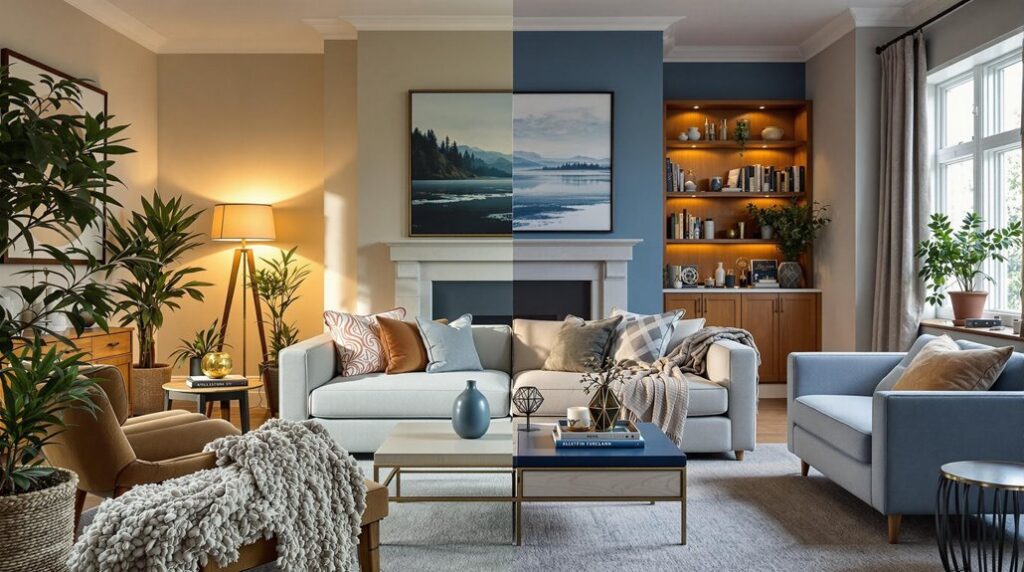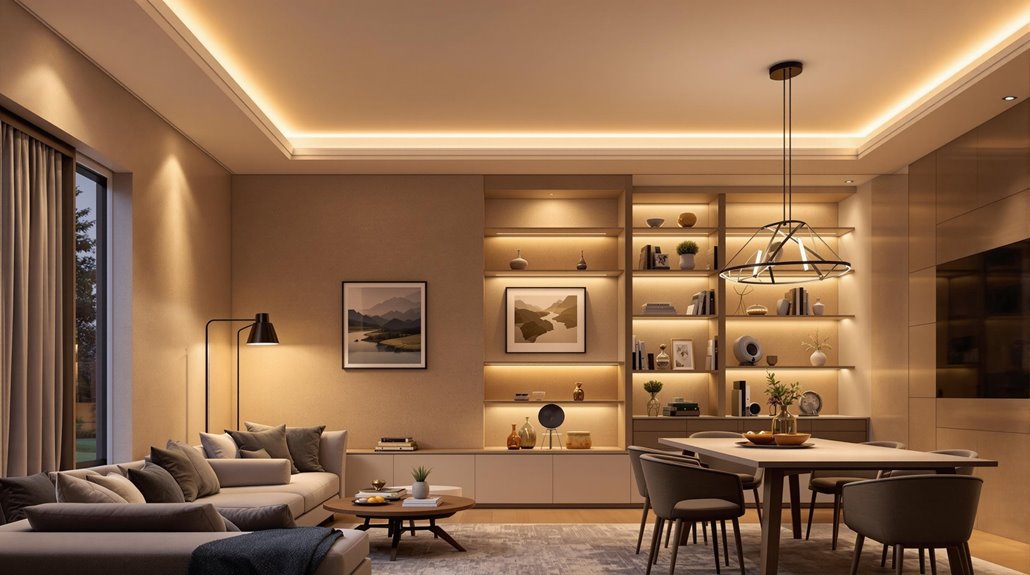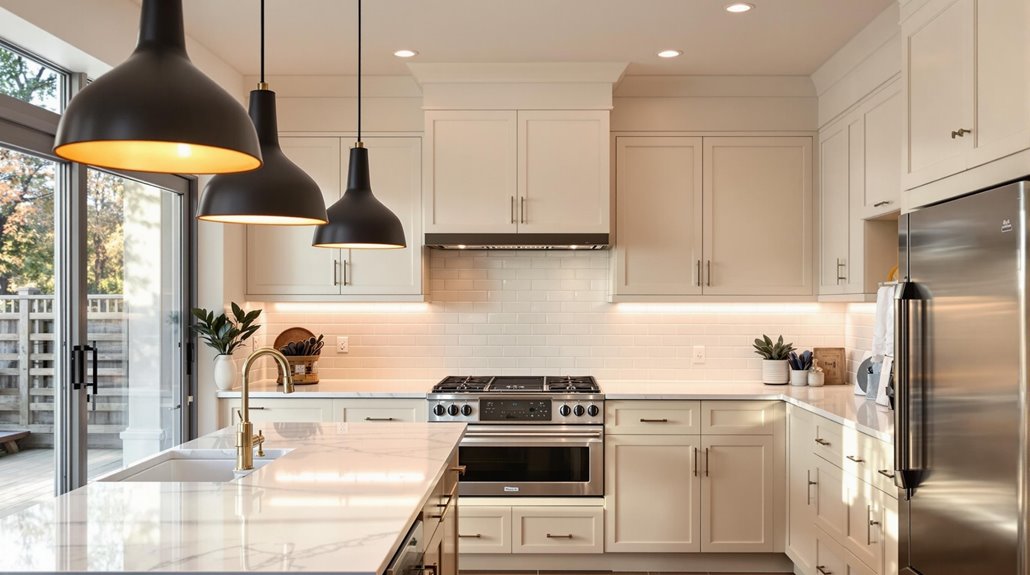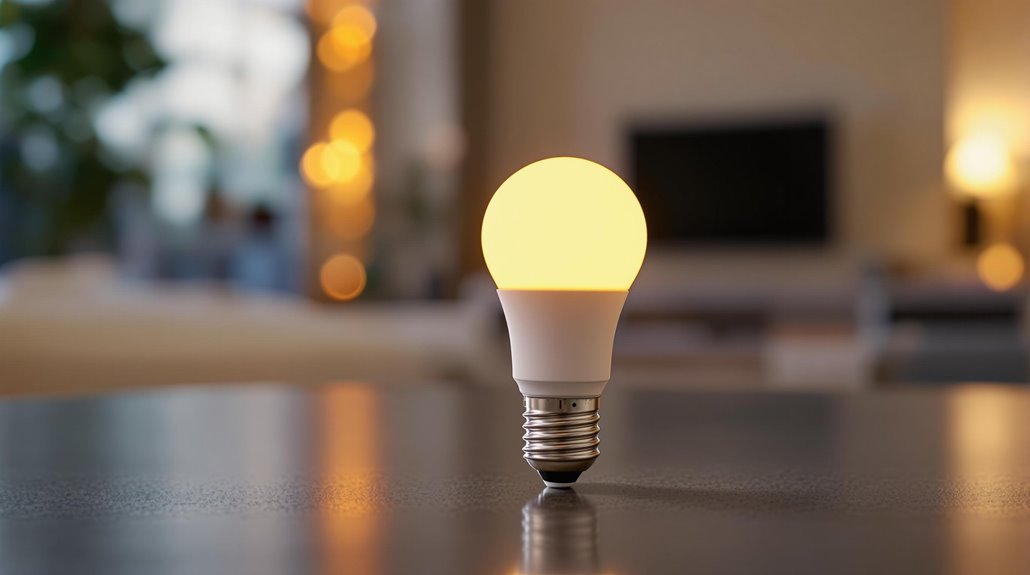I’ve spent years helping UK homeowners transform their spaces through strategic lighting choices, and I can tell you that the warm versus cool lighting debate isn’t just about preference—it’s about creating environments that actually work for your lifestyle. The color temperature you choose directly impacts your sleep quality, productivity, and overall well-being in ways most people don’t realize. Before you make another lighting purchase, there’s something vital you need to understand about how different temperatures affect your daily routines.
Key Takeaways
- Warm lighting (2700K-3000K) creates cozy atmospheres and supports natural sleep cycles by reducing cortisol levels.
- Cool lighting (≥5000K) resembles bright daylight but disrupts circadian rhythms and increases eye strain.
- LED technology offers 75% energy savings and 25x longer lifespan, with UK market reaching 70% share by 2025.
- Bedrooms benefit from warm dimmable bulbs while kitchens need cool task lighting over work surfaces.
- Moisture-resistant IP44-rated fixtures are mandatory in UK bathrooms and kitchens under Building Regulations Part C.
Understanding Color Temperature: The Science Behind Warm and Cool Light
When you flip a light switch, you’re encountering a fundamental physics concept called color temperature—a parameter that describes light’s color by comparing it to an ideal black body radiator. Measured in kelvins (K), this scale works counterintuitively: lower K values produce warmer hues like yellow and red, while higher K values create cooler blue tones.
I’ll explain the mechanics: as you heat a black body, it shifts from red through orange, yellow, white, and finally blue. This gives us our reference point. Warm light sits at ≤3500K, mimicking sunset’s cozy glow. Cool light reaches ≥5000K, resembling bright daylight. Natural sunlight has a color temperature of approximately 5900K, though atmospheric effects can alter its perceived appearance throughout the day.
Understanding this science helps you choose lighting that creates the atmosphere you want in your home spaces.
Health Effects of Different Light Temperatures in UK Homes
Since color temperature affects more than just ambiance, understanding its health implications becomes essential for UK homeowners making lighting decisions. I’ve found that cool lighting above 4000K disrupts your circadian rhythm by suppressing melatonin production, leading to poor sleep quality and delayed sleep onset. You’ll experience increased eye strain from intense blue wavelengths, particularly problematic during our dark winter months when we rely heavily on artificial lighting. Additionally, high energy consumption during these periods can lead to increased heating costs, which adds to the importance of mindful lighting choices.
Warm lighting between 2700K-3000K supports your natural sleep cycles and reduces cortisol levels. I recommend switching to warm LEDs in bedrooms and living areas, especially for evening use. This becomes particularly important for children and elderly family members who’re more vulnerable to cool light’s negative effects on sleep patterns and eye health. Poor lighting choices can contribute to sleep deprivation, which research suggests may increase risks of long-term health conditions including dementia.
Energy Efficiency and LED Technology Trends Across England
As England pushes toward its ambitious 2030 energy reduction targets, LED technology has emerged as the cornerstone of residential lighting efficiency. I’ve witnessed firsthand how these advanced bulbs deliver remarkable performance—consuming 75% less energy while lasting 25 times longer than traditional incandescent lighting.
What’s particularly impressive is LED’s 90% conversion efficacy, meaning virtually no energy gets wasted as heat. This efficiency translates directly into lower electricity bills for your household. Moreover, implementing draft-proofing front doors can further enhance your home’s insulation and energy savings.
The UK’s LED market is experiencing explosive growth, with adoption rates climbing 20% annually toward a projected 70% market share by 2025. Smart LED integration is revolutionizing how we control lighting through IoT systems and AI-driven automation.
Beyond energy savings, LED technology supports your ESG goals through environmental impact reduction, adjustable lighting for wellbeing, and compliance data tracking. Modern LED bulbs have achieved impressive lumen output efficiency improvements, jumping from less than 75 lm/W in 2010 to 107 lm/W in 2020.
Safety Considerations and Practical Design for Home Lighting
The impressive energy efficiency of LED technology doesn’t automatically guarantee safe home lighting installations. I’ll emphasize that Building Regulations Part C requires moisture-resistant downlights in bathrooms and kitchens to prevent condensation damage. You must install Part C compliant fixtures with proper moisture seals to avoid damp and mould issues. Additionally, ventilation systems like PIV can help manage humidity levels in these areas, further reducing the risk of moisture-related problems.
While emergency lighting isn’t mandatory for private homes, I recommend considering BS 5266 standards for key areas like staircases and corridors. Battery-backed lights that automatically activate during power failures can prevent accidents in the dark. Focus on illuminating escape routes and highlighting obstacles or level changes. Modern LED emergency lighting systems provide improved efficiency and longer operational life compared to traditional alternatives.
For multi-occupancy residences, the Fire Safety Order 2005 requires emergency lighting in communal areas. Regular monthly testing verifies your emergency systems function when needed most.
Room-by-Room Lighting Recommendations for Optimal Home Ambience
When designing lighting for each room in your home, you’ll need to contemplate specific functional requirements alongside aesthetic preferences. Your bedroom benefits from warm 2700K bulbs with dimming capabilities, creating restful environments while providing adequate task lighting for reading. I’d recommend layering ambient, accent, and task lighting throughout your living spaces.
In bathrooms, you’ll want IP44-rated fixtures that blend atmospheric glow with practical illumination for grooming tasks. Your kitchen requires bright, cool-toned lighting over work surfaces, contrasted with warmer ambient lighting for dining areas. Kitchen work surfaces should maintain a minimum of 400 lux to ensure safe food preparation and cooking activities.
Hallways need strategic placement of wall-mounted fixtures to guarantee safe navigation while highlighting architectural features. For outdoor spaces, portable lighting solutions offer flexibility for entertaining while extending your living areas into garden settings year-round.
Conclusion
I’ve shown you how warm and cool lighting each serve specific purposes in your UK home. You’ll want warm 2700K-3000K bulbs in bedrooms and living areas for relaxation, while cool 4000K+ works best in kitchens and workspaces. Don’t overlook energy efficiency with LED technology and guarantee proper safety installations. By matching color temperature to each room’s function, you’ll create ideal ambience that supports both your circadian rhythms and daily productivity needs.
References
- https://pmc.ncbi.nlm.nih.gov/articles/PMC7828303/
- https://journals.sagepub.com/doi/10.1177/14771535211021064
- https://assets.publishing.service.gov.uk/media/620e3bbb8fa8f54911e22180/Energy_Report_2019-20.pdf
- https://www.directtradesupplies.co.uk/blog/a-century-of-evolution-in-home-lighting/
- https://www.sciencemuseum.org.uk/objects-and-stories/everyday-wonders/electric-lighting-home
- https://en.wikipedia.org/wiki/Color_temperature
- https://blog.etcconnect.com/a-quick-definition-of-color-temperature-and-cct
- https://www.redgrasscreative.com/lighting-color-temperature-kelvin/
- https://www.studiobinder.com/blog/what-is-color-temperature-definition/
- https://www.tcpi.com/what-is-lighting-color-temperature/




